Broadcom BRCM1065 802.11bgn WLAN + BT Combo Card User Manual Miix 10 UG EN
Broadcom Corporation 802.11bgn WLAN + BT Combo Card Miix 10 UG EN
Broadcom >
Contents
User manual 1 of 2
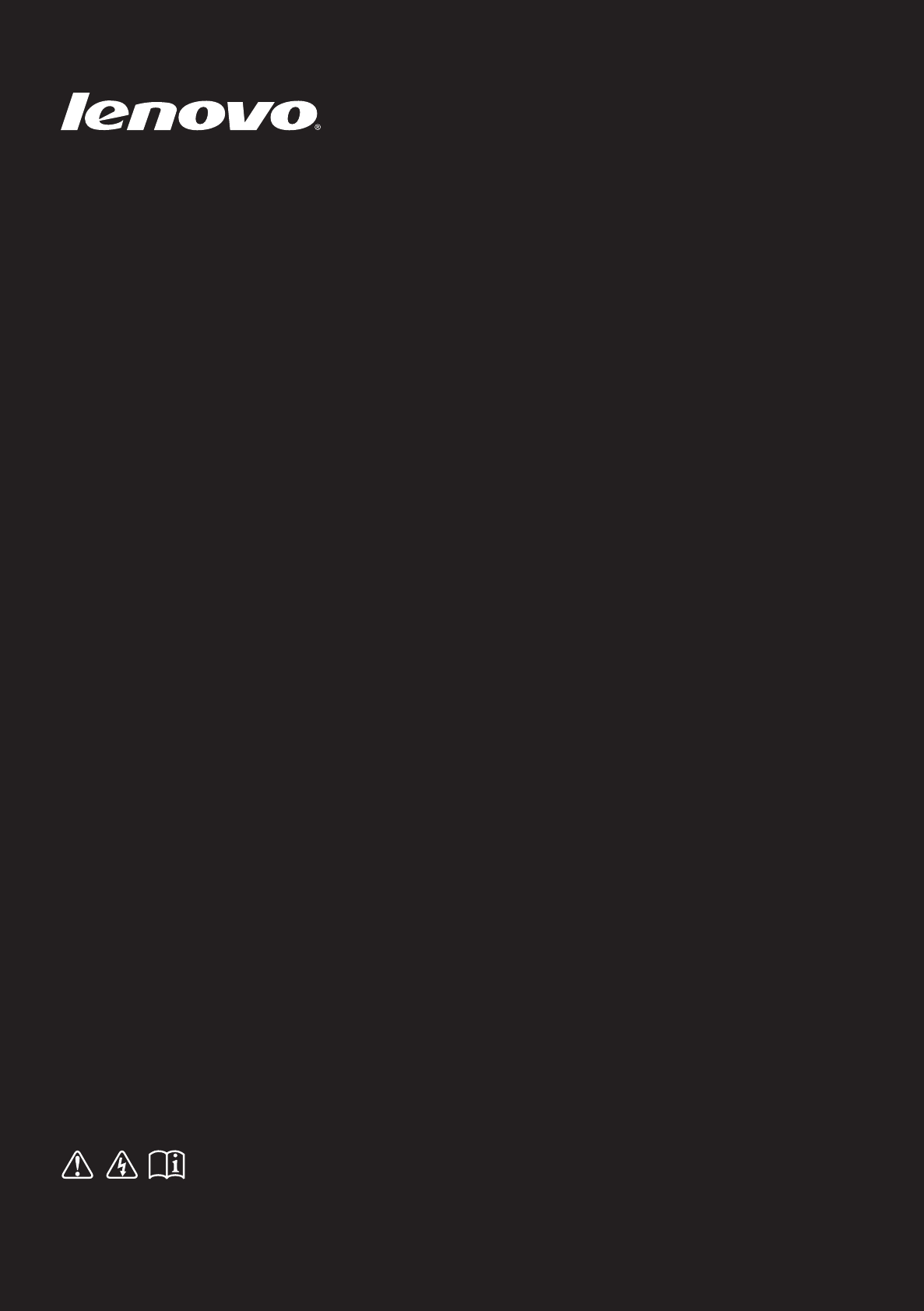
Read the safety notices and important tips in the
included manuals before using your computer.
User Guide
Lenovo IdeaPad Miix 10
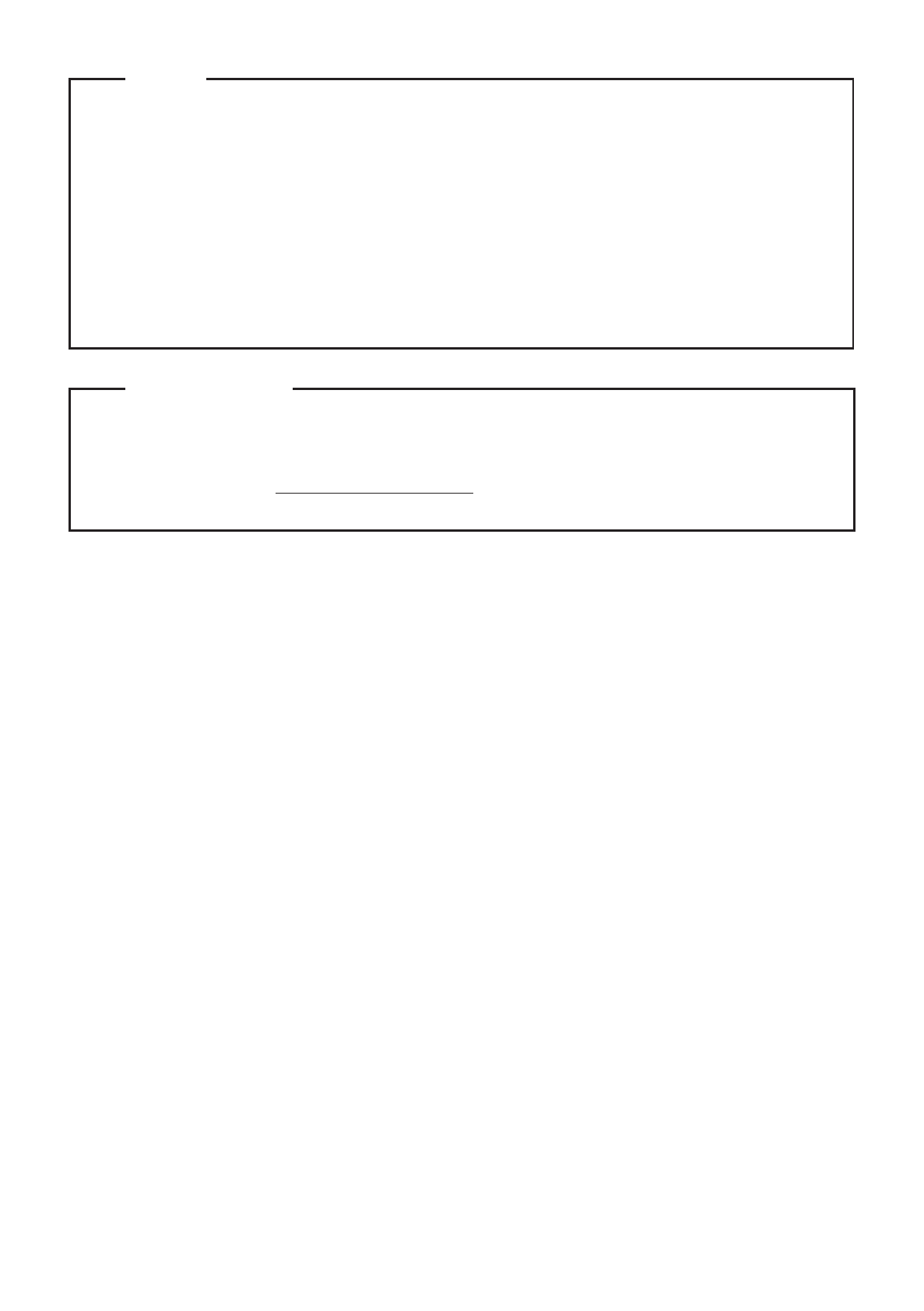
First Edition (April 2013)
© Copyright Lenovo 2013.
LIMITED AND RESTRICTED RIGHTS NOTICE: If data or software is delivered pursuant to a General
Services Administration “GSA” contract, use, reproduction, or disclosure is subject to restrictions set
forth in Contract No. GS-35F-05925.
The Regulatory Notice provides information about the radio frequency and safety
standards. Be sure to read it before using wireless devices on your computer.
To refer to it, go to http://www.lenovo.com, click Support, and then click User’s guides
and manuals.
Regulatory Notice
Before using the product, be sure to read Lenovo Safety and General Information Guide first.
The features described in this guide are common to most models. Some features may not
be available on your computer or your computer may include features that are not
described in this user guide.
Some instructions in this guide may assume that you are using Windows
®
8. If you are
using another Windows operating system, some operations may be slightly different. If
you are using other operating systems, some operations may not apply to you.
Notes
•
•
•
The illustrations in this manual may differ from the actual product. Please refer to the
actual product.
•
•
•
i
Chapter 1. Getting to know your computer ..................................................................................... 1
Top view......................................................................................................................................................... 1
Left-side view ................................................................................................................................................ 3
Front view ...................................................................................................................................................... 4
Rear view........................................................................................................................................................ 4
Bottom view ................................................................................................................................................... 5
Folio case top view........................................................................................................................................ 6
Chapter 2. Starting to use Windows 8.............................................................................................. 8
Configuring the operating system for the first time ................................................................................ 8
Operating system interfaces ........................................................................................................................ 8
The charms ..................................................................................................................................................... 9
Putting the computer to sleep or shutting it down ................................................................................ 11
Touch screen operation ..............................................................................................................................13
Connecting to wireless LAN ..................................................................................................................... 17
Help and support........................................................................................................................................ 19
Recovery system.......................................................................................................................................... 20
Chapter 3. Troubleshooting ............................................................................................................ 21
Frequently asked questions ....................................................................................................................... 21
Troubleshooting.......................................................................................................................................... 22
Trademarks....................................................................................................................................... 25
Contents
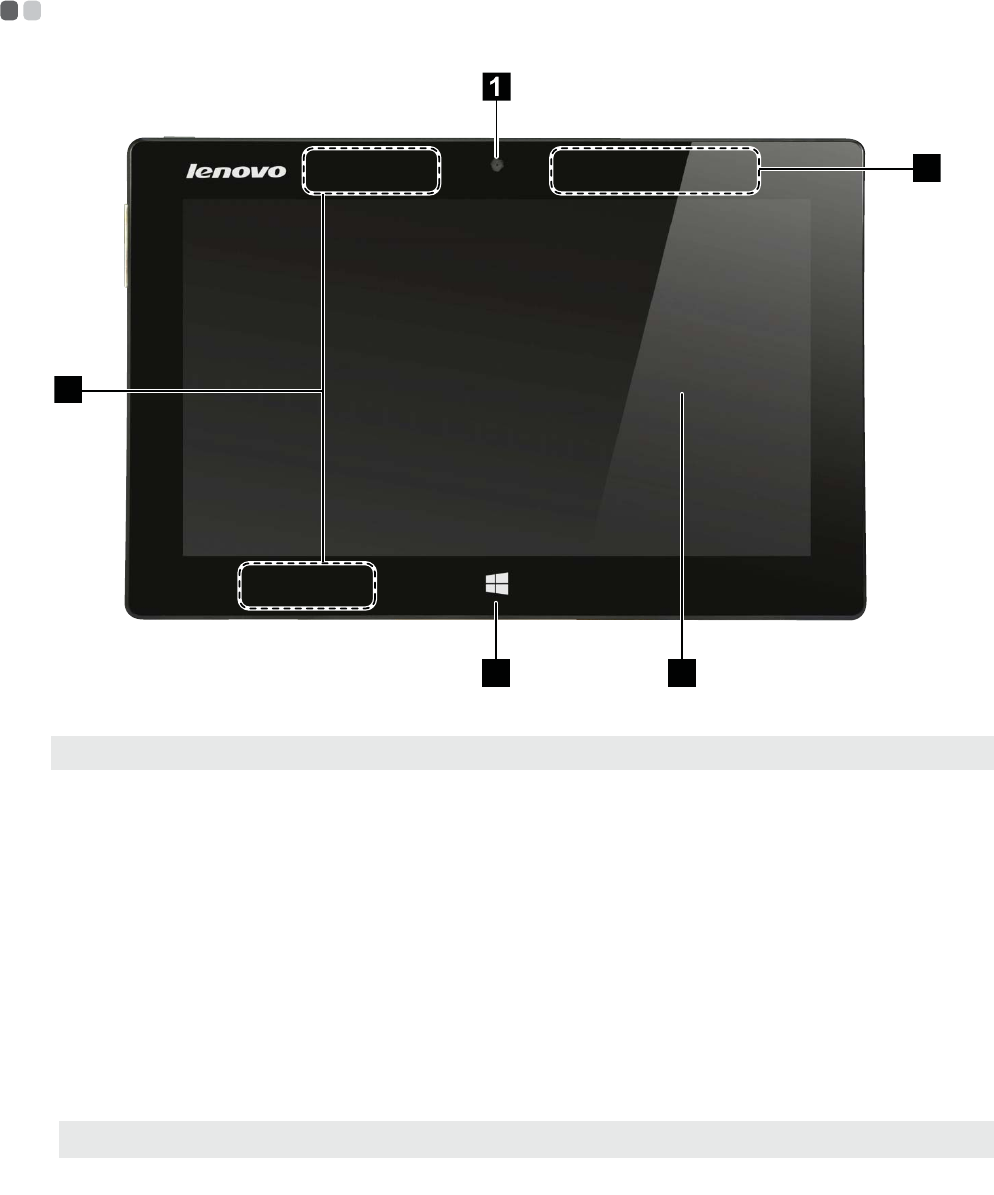
1
Chapter 1. Getting to know your computer
Top view - - - - - - - - - - - - - - - - - - - - - - - - - - - - - - - - - - - - - - - - - - - - - - - - - - - - - - - - - - - - - - - - - - - - - - - - - - - - - - - - - - - - - - - - - - - - - - - - - - - - - - - - - - - - - - - - - - - - - - - - - -
Note: The dashed areas indicate parts that are not visible externally.
Integrated camera (on
select models)
Use the camera for video communication.
Wireless LAN
antennas
Connects to the wireless LAN adapter to send and receive
wireless radio signals.
Windows button Press this button to:
Toggle between the current view and the Start screen.
-or-
Wake up the computer from sleep mode.
Multi-touch screen Functions as the visual display as well as one of the two primary
input methods.
Note: For details, see “Touch screen operation” on page 13.
Wireless WAN
antennas (on select
models)
Connects to the wireless WAN adapter to send and receive
wireless radio.
3 4
2
5
a
b
c
d
e
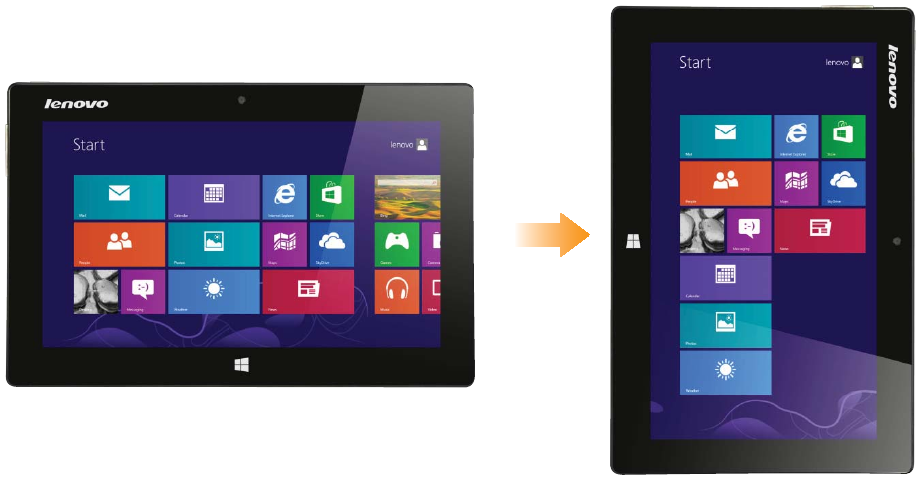
2
Chapter 1. Getting to know your computer
Screen orientation
You can rotate the display panel to your preferred orientation.
The orientation of the display automatically changes (alternating between portrait and
landscape modes) depending upon how you hold the computer.
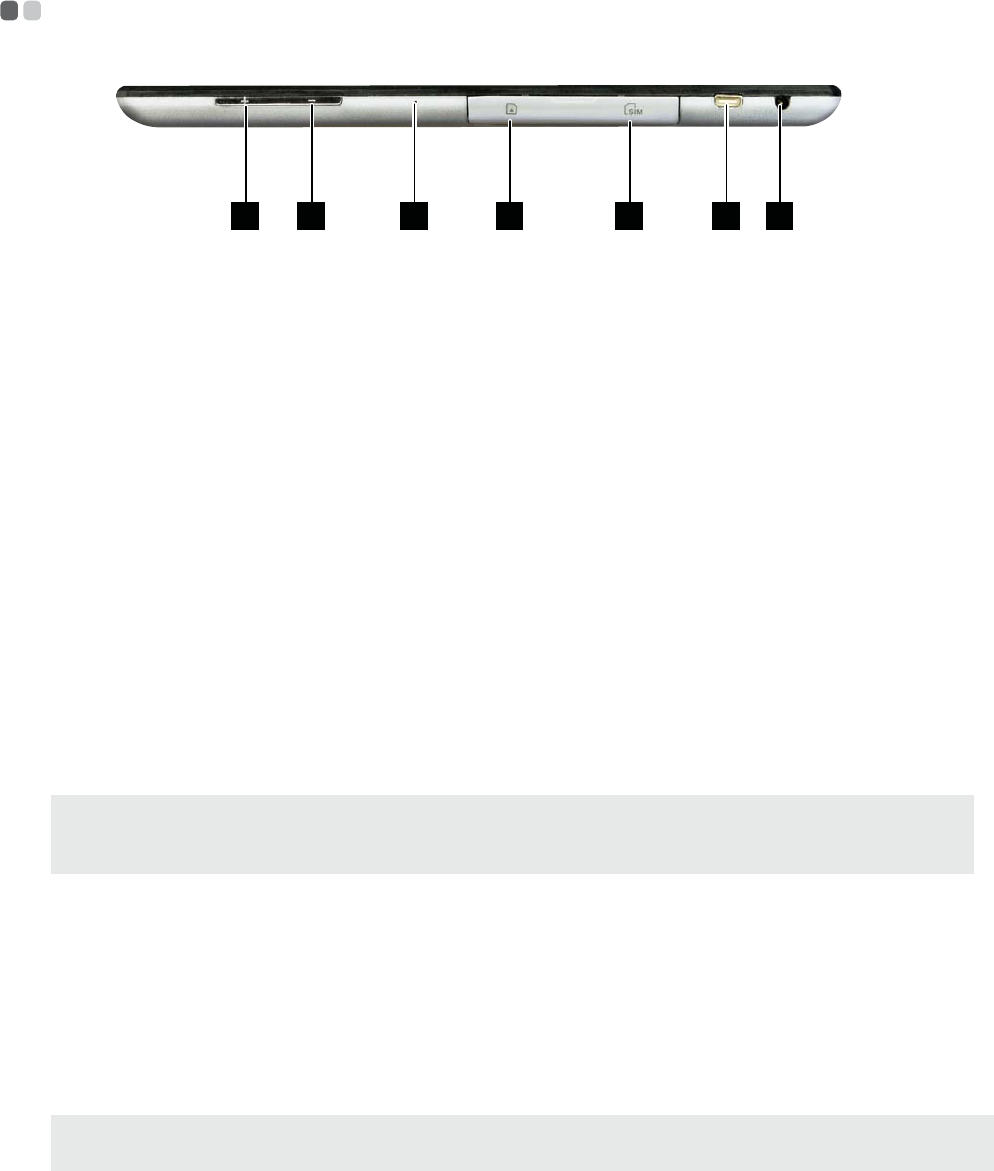
Chapter 1. Getting to know your computer
3
Left-side view - - - - - - - - - - - - - - - - - - - - - - - - - - - - - - - - - - - - - - - - - - - - - - - - - - - - - - - - - - - - - - - - - - - - - - - - - - - - - - - - - - - - - - - - - - - - - - - - - - - - - - - - - - - - -
Using micro SD card (not supplied)
Your computer supports micro Secure Digital (SD) cards.
Inserting a card
Slide the card in until it clicks into place.
Removing a card
1
Push the card in until you hear a click.
2
Gently pull the memory card out of the slot.
Volume up button Increases volume level.
Volume down button Decreases volume level.
Built-in microphone Capture sound which can be used for video conferencing, voice
narration, or audio recording.
Micro SD card slot Insert a micro SD card (not supplied) here.
SIM card slot Insert a SIM card (not supplied) here.
Micro HDMI port Connects to devices with HDMI inputs, such as a TV or an
external display.
AC power adapter
jack
Connects the AC power adapter here.
Notes:
•Insert only one card into the slot at a time.
•This card reader does not support SDIO devices (e.g., SDIO Bluetooth, etc.).
Note: Before removing the memory card, disable it by using the Windows safely remove hardware and
eject media utility to avoid data corruption.
4321 5 6 7
a
b
c
d
e
f
g
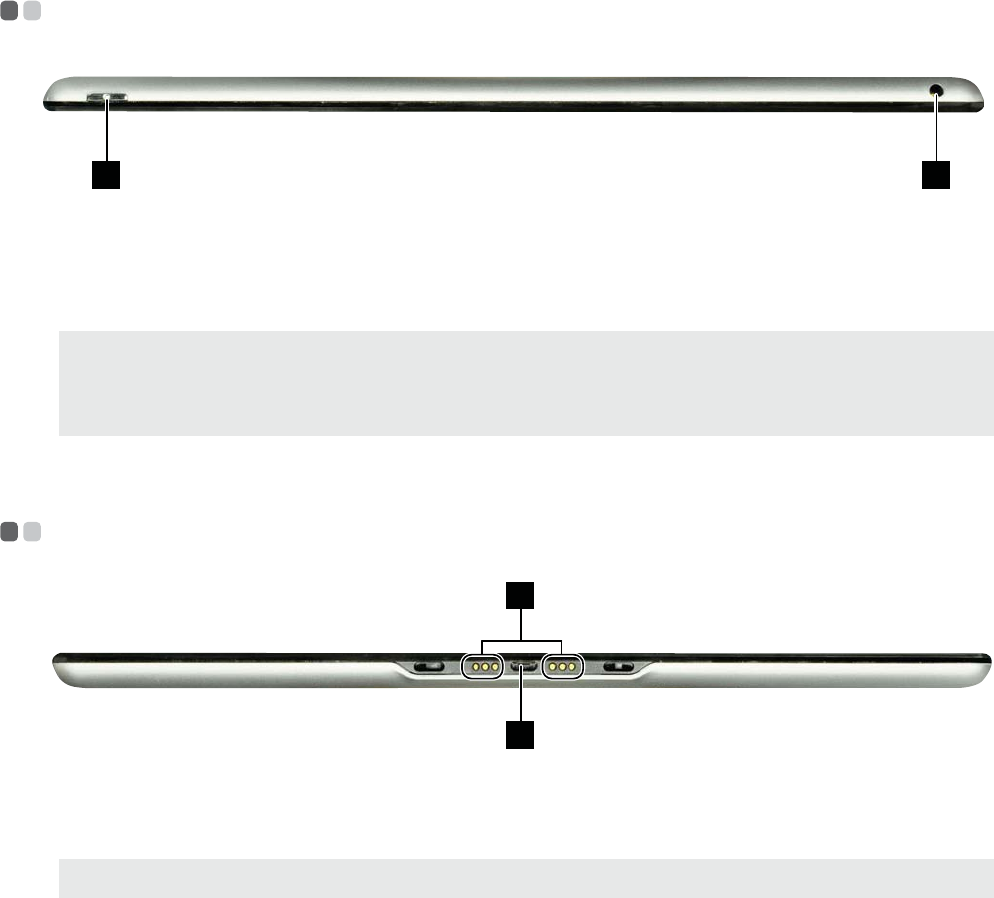
4
Chapter 1. Getting to know your computer
Front view - - - - - - - - - - - - - - - - - - - - - - - - - - - - - - - - - - - - - - - - - - - - - - - - - - - - - - - - - - - - - - - - - - - - - - - - - - - - - - - - - - - - - - - - - - - - - - - - - - - - - - - - - - - - - - - - - - - - -
Rear view - - - - - - - - - - - - - - - - - - - - - - - - - - - - - - - - - - - - - - - - - - - - - - - - - - - - - - - - - - - - - - - - - - - - - - - - - - - - - - - - - - - - - - - - - - - - - - - - - - - - - - - - - - - - - - - - - - - - - - -
Power button Press this button to turn on the computer.
Combo audio jack Connects to headsets.
Notes:
•The combo audio jack does not support conventional microphones.
•The recording function may not be supported if third-party headphones or headsets are connected,
due to different industry standards.
Tablet connector Connects the tablet to the folio case.
Micro USB port Connects to USB devices.
Note: The Micro USB port does not support the charging function.
1 2
a
b
2
1
a
b
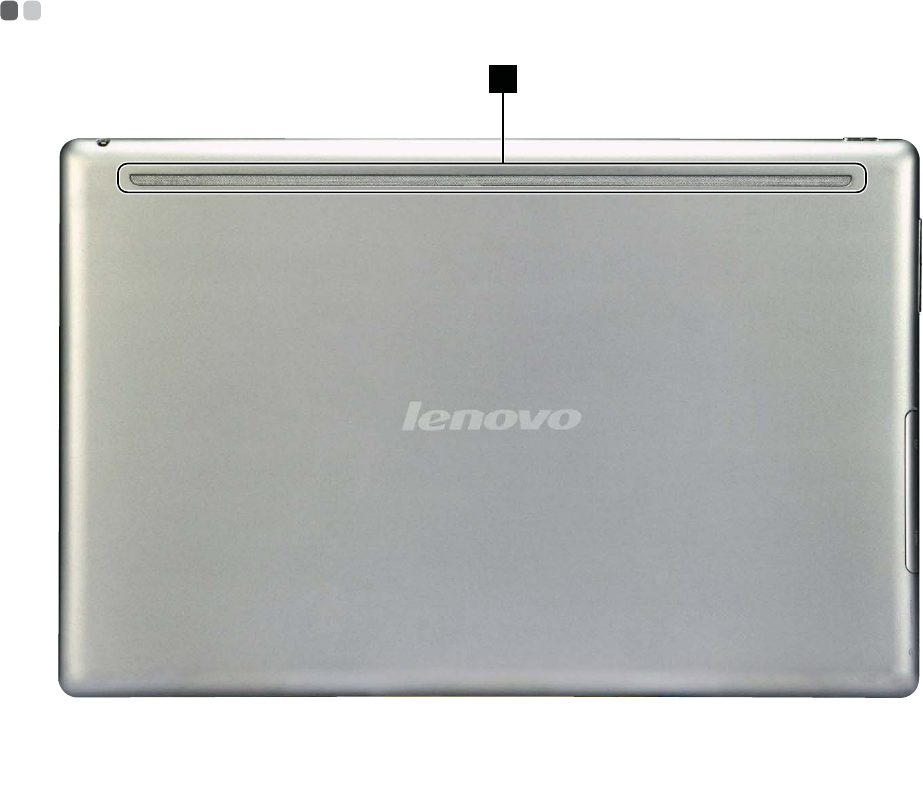
Chapter 1. Getting to know your computer
5
Bottom view - - - - - - - - - - - - - - - - - - - - - - - - - - - - - - - - - - - - - - - - - - - - - - - - - - - - - - - - - - - - - - - - - - - - - - - - - - - - - - - - - - - - - - - - - - - - - - - - - - - - - - - - - - - - - - - - -
Speakers Provide audio output.
1
a
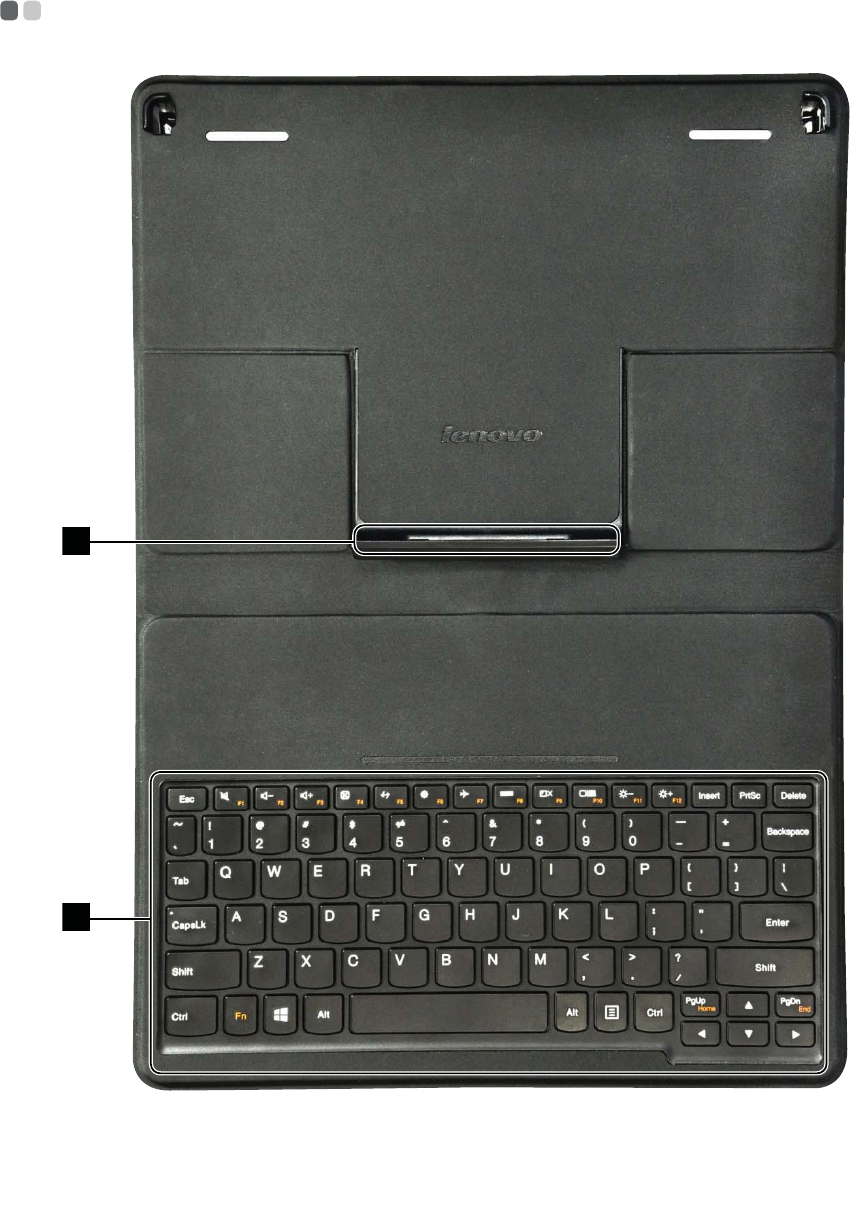
6
Chapter 1. Getting to know your computer
Folio case top view - - - - - - - - - - - - - - - - - - - - - - - - - - - - - - - - - - - - - - - - - - - - - - - - - - - - - - - - - - - - - - - - - - - - - - - - - - - - - - - - - - - - - - - - - - - - - -
Tablet connector Connects the tablet to the folio case.
Keypad The keypad functions as a conventional keyboard.
1
2
a
b
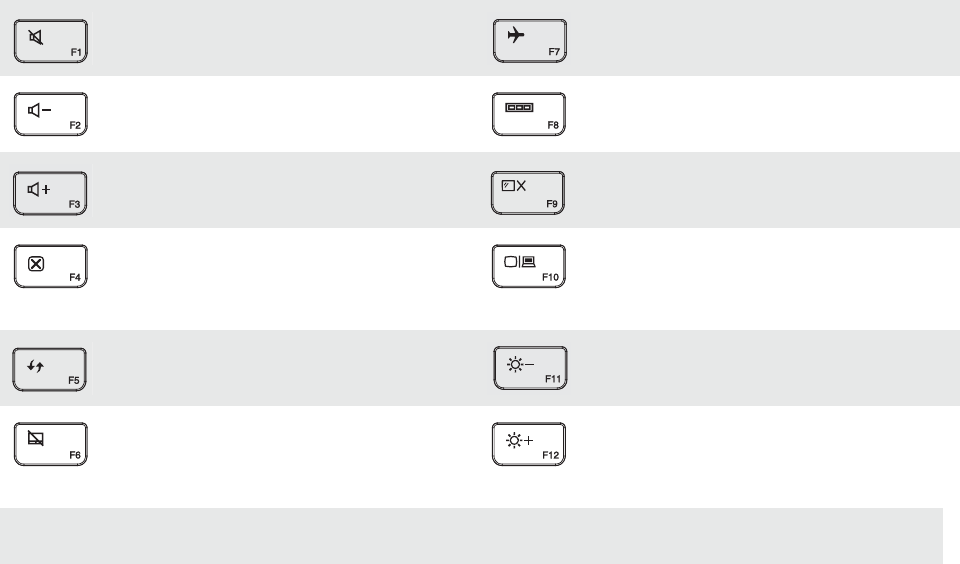
Chapter 1. Getting to know your computer
7
Keypad function keys
You can access certain system settings quickly by pressing the appropriate function keys.
:Mutes/unmutes the sound. :Enables/disables Airplane
mode.
:Decreases the volume level. :Displays all currently active
apps.
:Increases the volume level. :Turns on/off the backlight of
the LCD screen.
:Closes the currently active
window.
:Toggles the display between the
computer and an external
device.
:Refreshes the desktop or the
currently active window. :Decreases the display
brightness.
:
Enables/disables the touch pad
. :Increases the display
brightness.
Note: The keypad is automatically locked if the screen is opened less than 40 degrees or beyond 190
degrees.
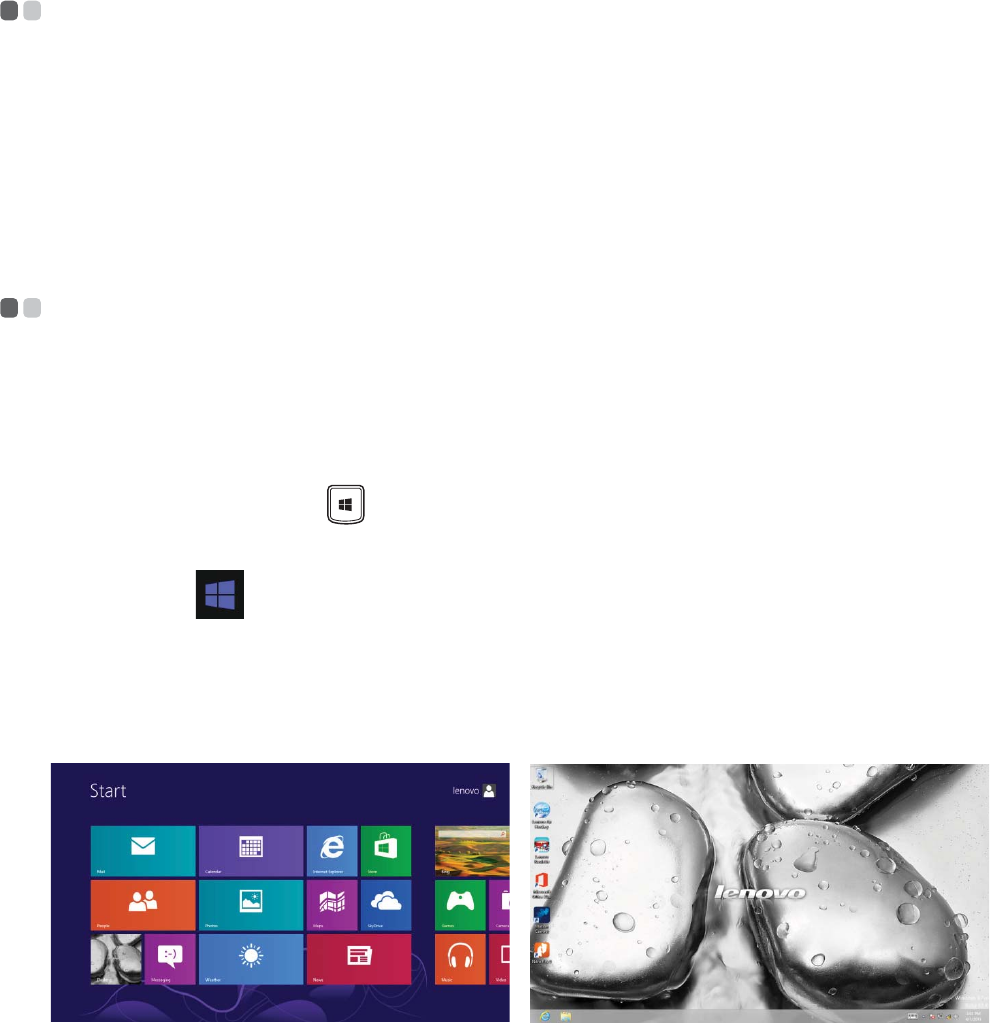
8
Chapter 2. Starting to use Windows 8
Configuring the operating system for the first time - - - - - - - - - - - - - - -
You may need to configure the operating system when it is first used. The configuration process
may include the procedures below:
• Accepting the end user license agreement
•Configuring the internet connection
•Registering the operating system
•Creating a user account
Operating system interfaces - - - - - - - - - - - - - - - - - - - - - - - - - - - - - - - - - - - - - - - - - - - - - - - - - - - - - - - - - - - - - - - - - - - - - - - -
Windows 8 comes with two main User Interface: the Start screen and the desktop.
To switch from the Start screen to the desktop, do one of the following:
•Select the desktop tile on the Start screen.
•Press the Windows button.
•Press the Windows key ( ) + D. (located on the folio case)
To switch from the desktop to the Start screen, do one of the following:
•Select Start from the charms.
•Move the pointer to the lower-left corner and then select the Start screen thumbnail when it is
displayed.
Start screen Desktop
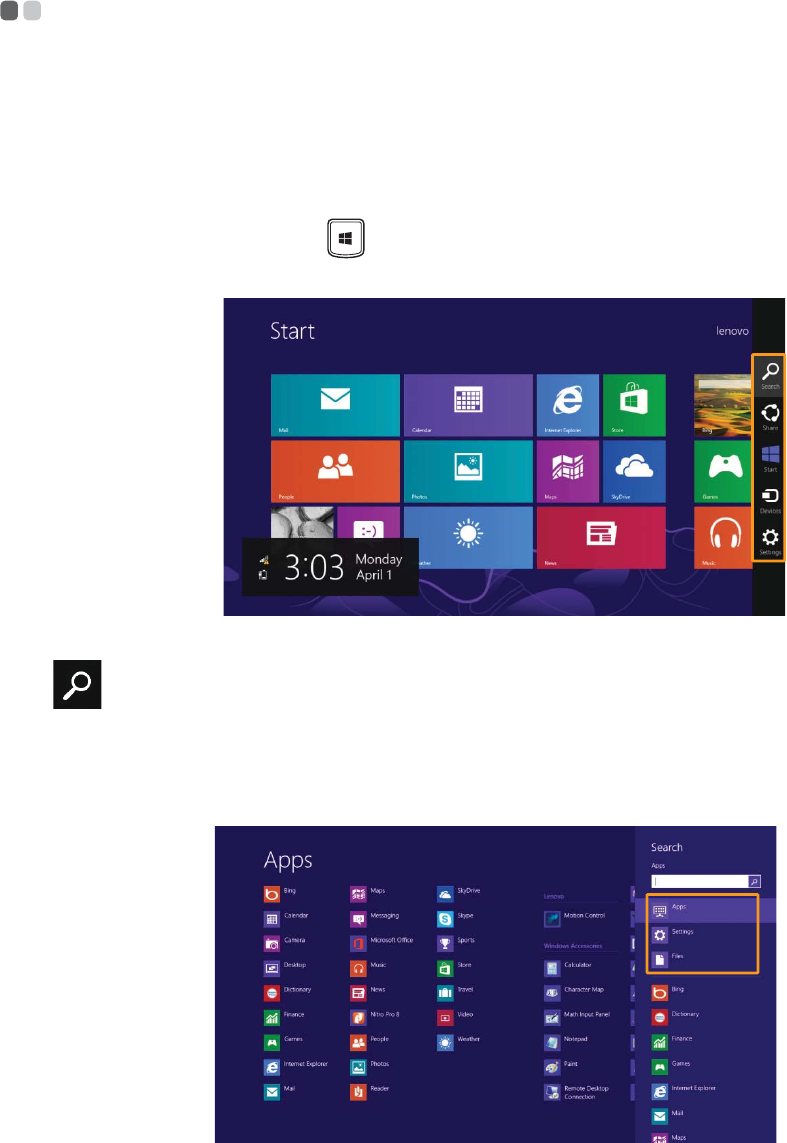
Chapter 2. Starting to use Windows 8
9
The charms - - - - - - - - - - - - - - - - - - - - - - - - - - - - - - - - - - - - - - - - - - - - - - - - - - - - - - - - - - - - - - - - - - - - - - - - - - - - - - - - - - - - - - - - - - - - - - - - - - - - - - - - - - - - - - - - - - -
The five charms provide new and faster ways to perform many basic tasks, and are always
available regardless of which app you are currently in.
To display the charms, do one of the following:
•Move the pointer to the upper-right or lower-right corner until the charms bar is displayed.
•Use one finger to swipe in from the right edge of the screen until the charms bar is displayed.
•Press the Windows key ( ) + C. (located on the folio case)
Search charm
The Search charm is a powerful new way to find whatever you are looking for, including apps,
settings and files.
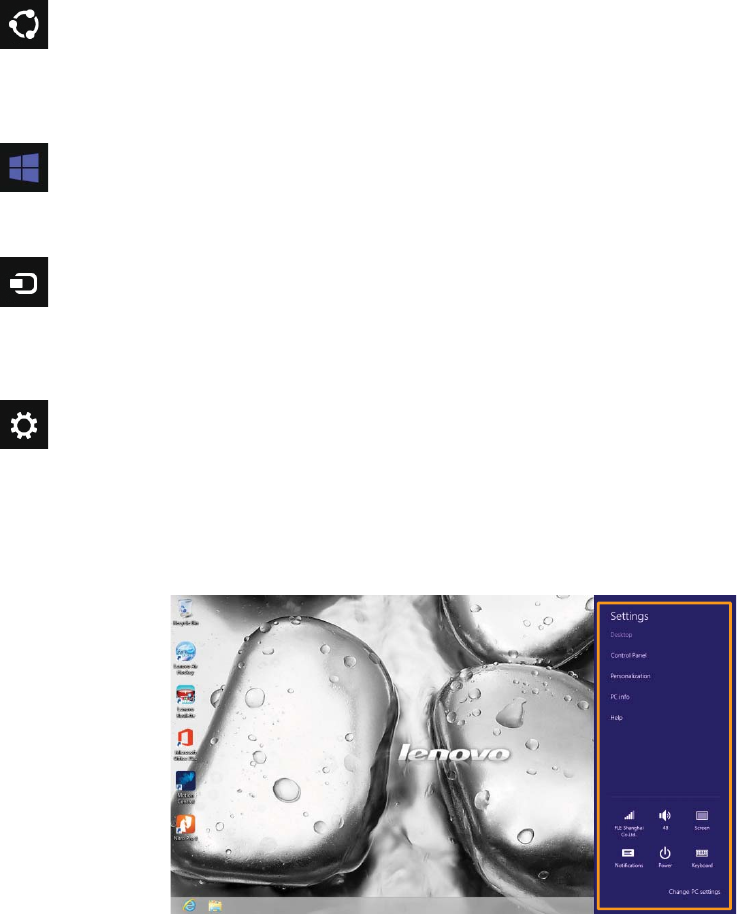
10
Chapter 2. Starting to use Windows 8
Share charm
The Share charm lets you send links, photos, and more to your friends and social networks
without leaving the app you are in.
Start charm
The Start charm is a fast way to go to the Start screen.
Devices charm
The Devices charm allows you to connect or send files to any external devices, such as digital
cameras, TVs, or printers.
Settings charm
The Settings charm lets you perform basic tasks, such as setting the volume or shutting down
the computer. Also, you can get to the Control Panel through the Settings charm when using the
desktop screen.
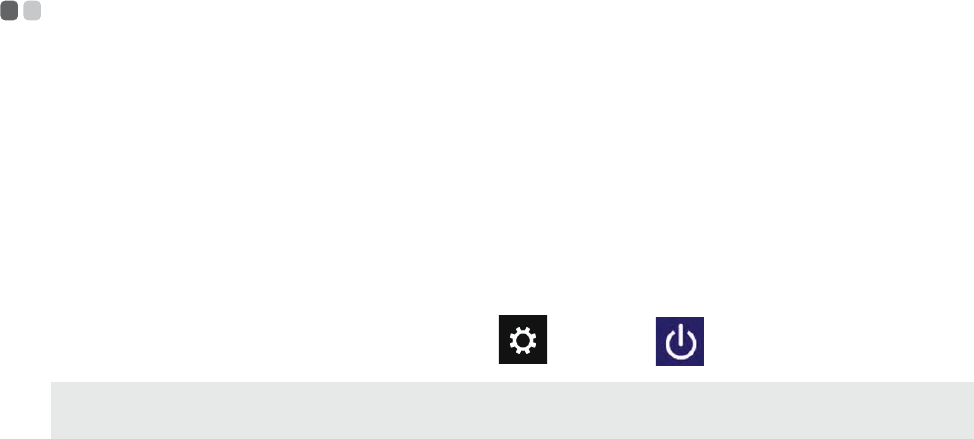
Chapter 2. Starting to use Windows 8
11
Putting the computer to sleep or shutting it down - - - - - - - - - - - - - - - - - - -
When you have finished working with your computer, you can put it to sleep or shut it down.
Putting your computer to sleep
If you will be away from your computer for a short time, put the computer to sleep.
When the computer is in sleep mode, you can quickly wake it to resume use, bypassing the
startup process.
To put the computer to sleep, do one of the following:
•Press the Power button.
•Open the charms and then select Settings o Power o Sleep.
To wake the computer, do one of the following:
• Press any key on the keypad. (located on the folio case)
•Press the Power button.
•Press the Windows button.
Note: Put your computer to sleep before you move it. Moving your computer while the hard disk is
spinning can damage the hard disk, causing loss of data.
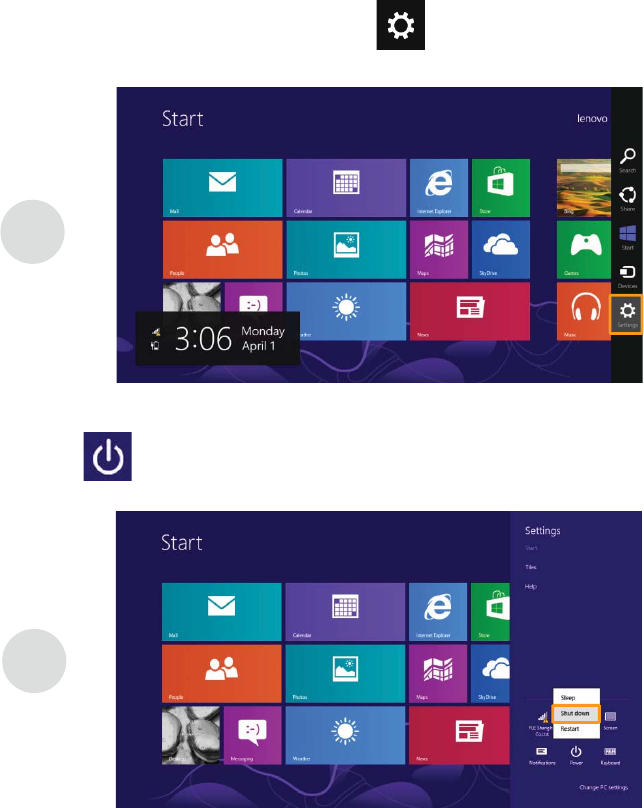
12
Chapter 2. Starting to use Windows 8
Shutting down the computer
If you are not going to use your computer for a long time, shut it down.
To shut down your computer:
1
Open the charms, and then select Settings .
2
Select Power o Shut down.
1
2
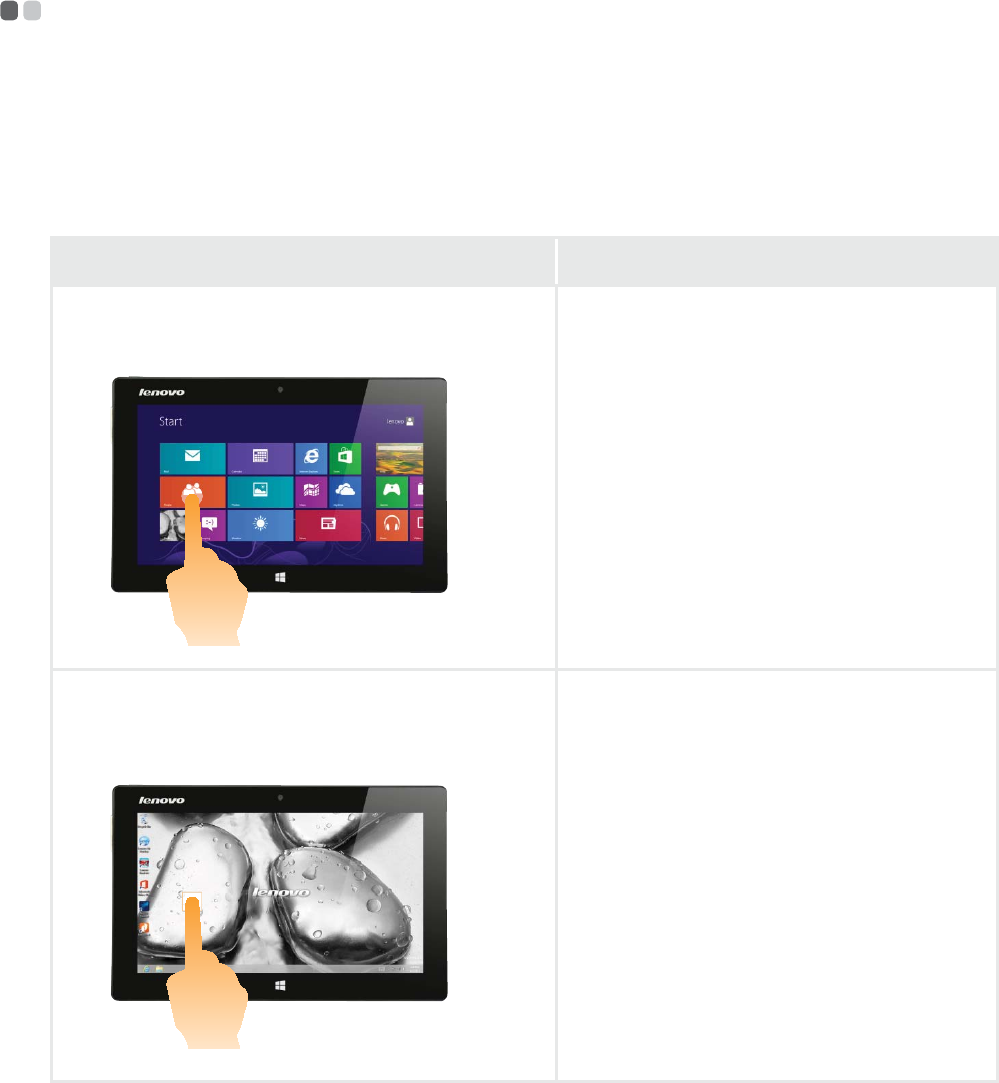
Chapter 2. Starting to use Windows 8
13
Touch screen operation - - - - - - - - - - - - - - - - - - - - - - - - - - - - - - - - - - - - - - - - - - - - - - - - - - - - - - - - - - - - - - - - - - - - - - - - - - - - - - - - - - - -
The display panel can accept inputs like a tablet, using the multi-touch screen, or like a
traditional notebook computer, using the keyboard and touch pad.
Multi-touch gestures
You can touch the screen with one or more fingertips to perform a variety of tasks.
Frequently used gestures Tasks performed
Tap
Tap once on an item.
Performs an action, such as starting an
app, opening a link, or performing a
command. Similar to left-clicking with a
mouse.
Press and hold
Press your finger down and leave it there for a
moment.
Allows you to see detailed information
before selecting an action. Can also open a
menu with more options. Similar to right-
clicking with a mouse.
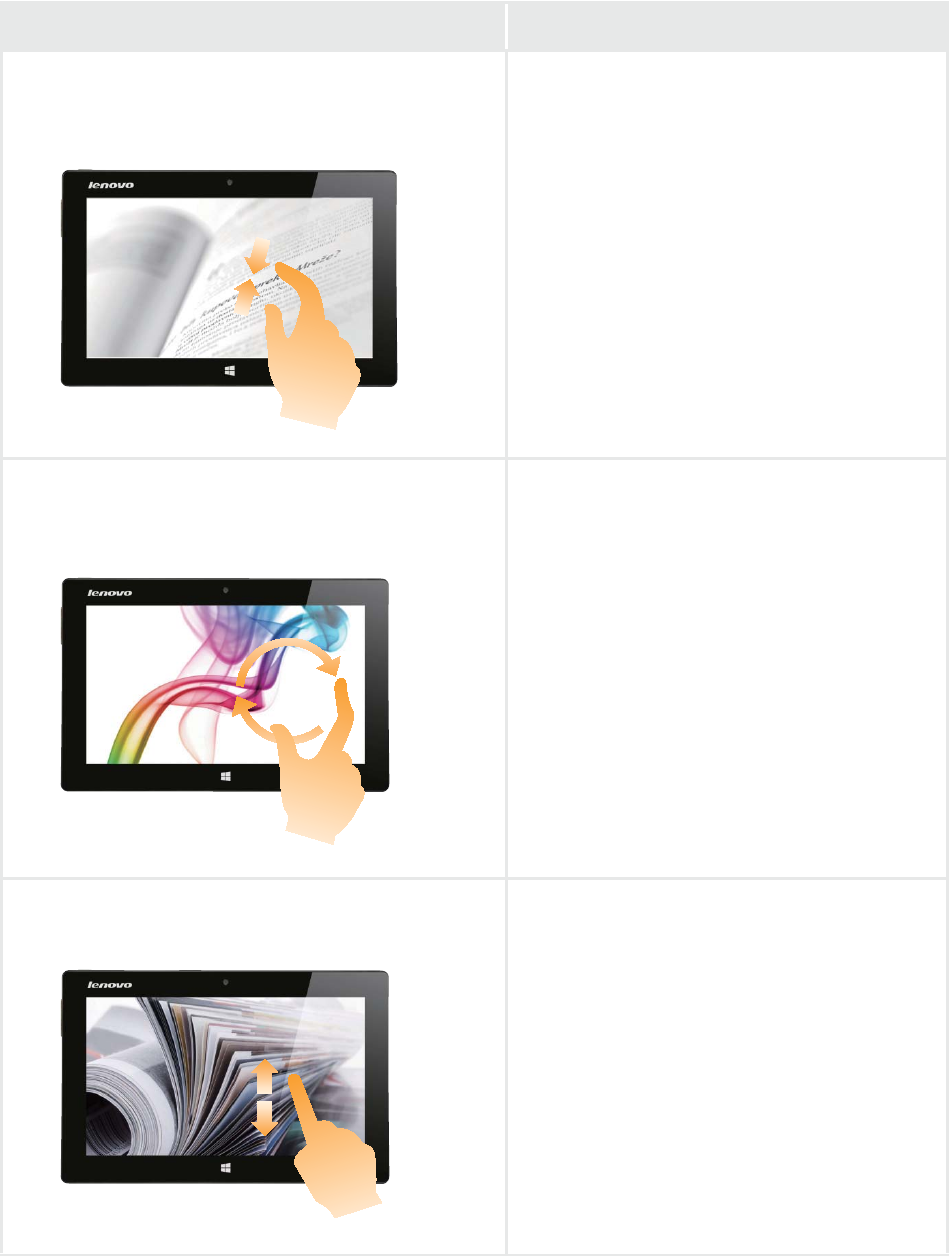
14
Chapter 2. Starting to use Windows 8
(continued)
Frequently used gestures Tasks performed
Zoom
Move two fingers together or apart while
touching the screen.
Zooms in and out on visual apps, such as
pictures and maps. Can also jump to the
beginning or end of a list.
Rotate
Place two or more fingers on an item and then
turn your hand.
Turns an object. (Note: Not all items can
be rotated, depending upon the app.)
Slide
Drag your finger across the screen.
Pans or scrolls through lists and pages.
Can also move an object or be used to
draw or write, depending upon the app.
Similar to pressing and holding to pan
and to scrolling with a mouse.
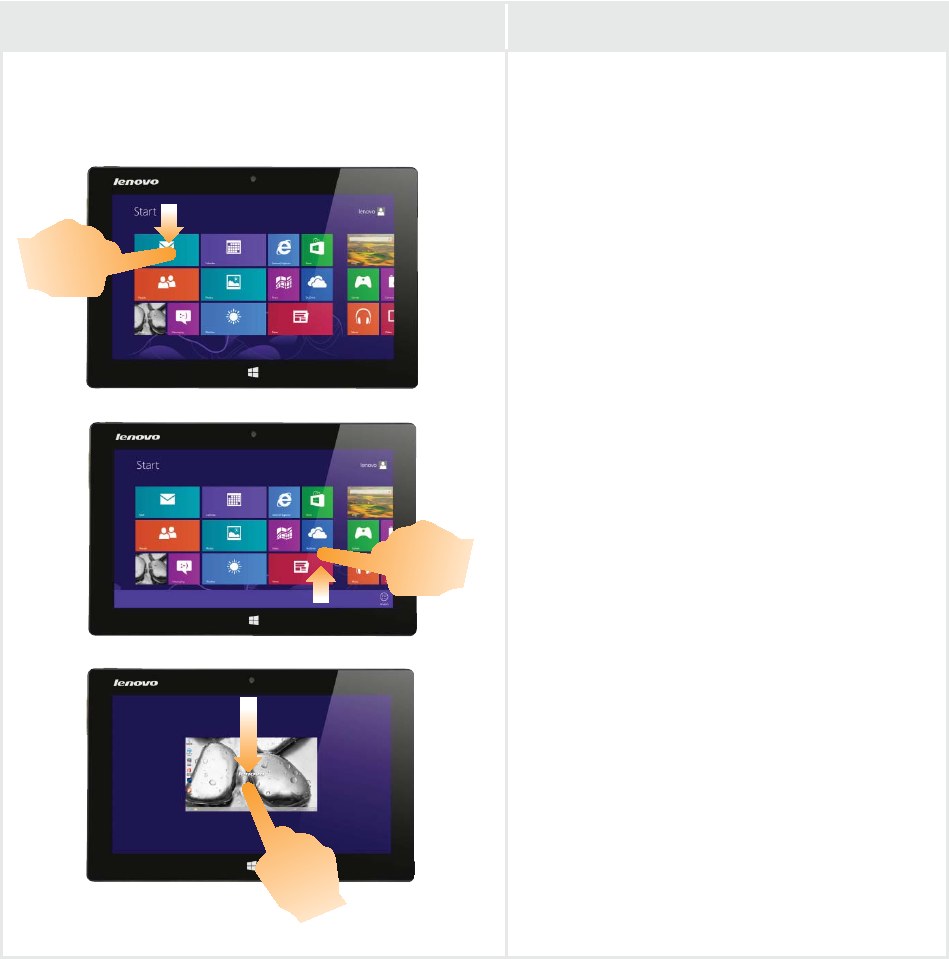
Chapter 2. Starting to use Windows 8
15
(continued)
Frequently used gestures Tasks performed
Swipe
Start from any edge of the screen, then swipe
inwards toward the center.
Swiping down from the top edge or up
from the bottom edge displays a task bar
on the bottom of the screen with app
commands, including save, edit, and
delete.
If you have an app currently open, you
can also:
•Swipe from the top edge to halfway
down the screen without lifting your
finger to dock that app on the left or
right side of the screen. This allows you
to keep two apps open simultaneously
in a split-screen format.
•Swipe from the top edge straight down
to the bottom edge of the screen
continuously without lifting your
finger to close the currently open app.
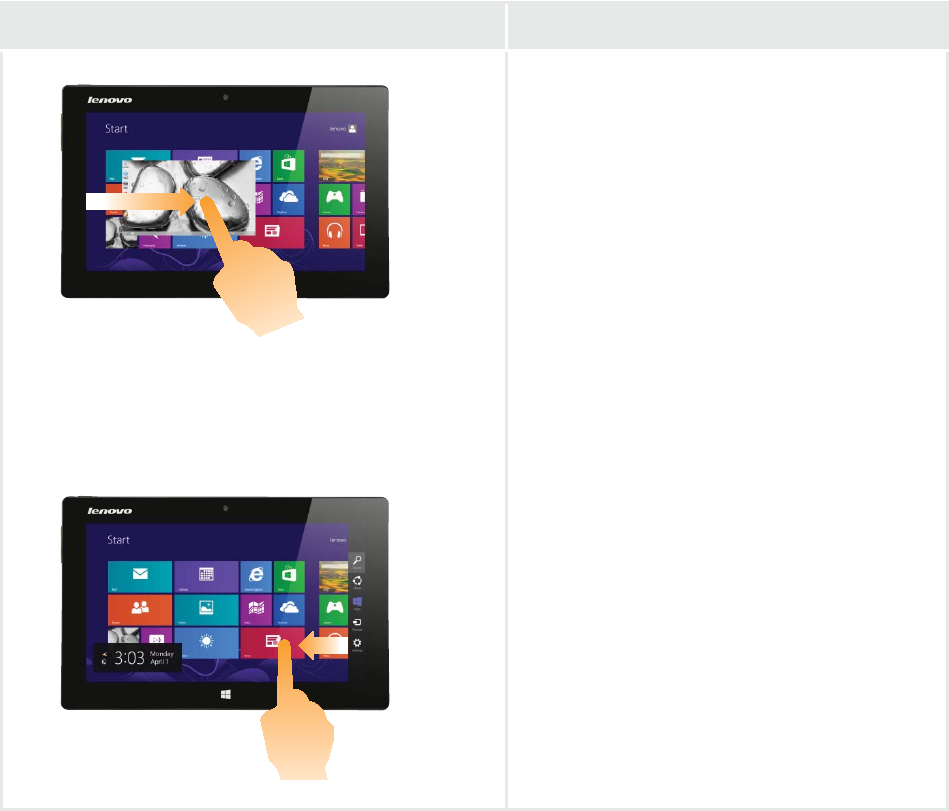
16
Chapter 2. Starting to use Windows 8
(continued)
Frequently used gestures Tasks performed
Swiping in from the left edge can:
•Bring in and open an app currently
running in the background.
If there is more than one currently open
app, you can:
•Swipe in from the left to bring in an
app and, without lifting your finger,
push that app quickly back off the left
edge of the screen. This displays a list
of the apps currently running in the
background.
Swiping in from the right edge of the
screen displays the charms.
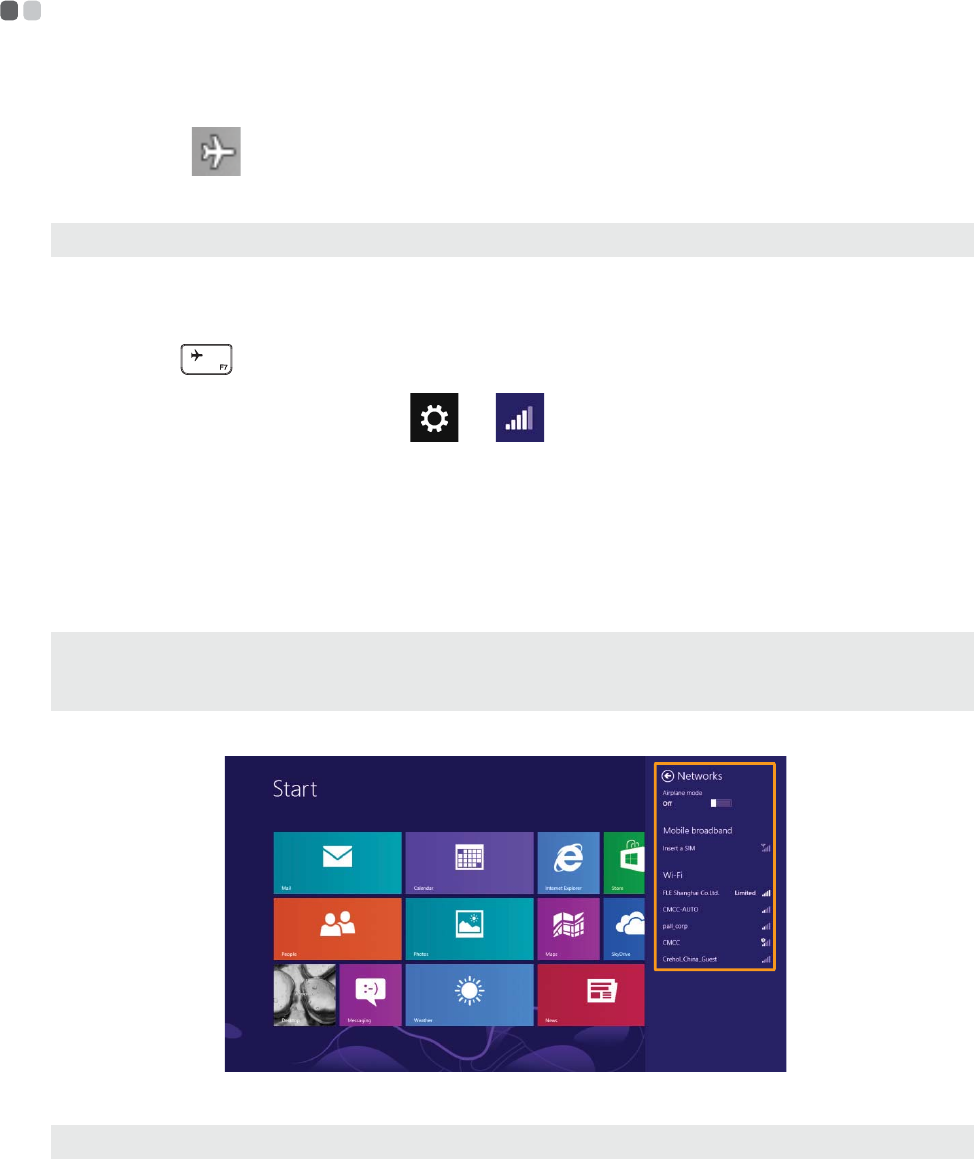
Chapter 2. Starting to use Windows 8
17
Connecting to wireless LAN - - - - - - - - - - - - - - - - - - - - - - - - - - - - - - - - - - - - - - - - - - - - - - - - - - - - - - - - - - - - - - - - - - - - - - - - - -
Enabling wireless connection
To confirm that Airplane mode is disabled, go to the desktop and check the notification area.
If you see the icon displayed on the lower right, then Airplane mode is on. Otherwise,
wireless function is enabled.
If Airplane mode is on, do one of the following to enable the wireless function:
•Press F7 ( ) to disable Airplane mode. (located on the folio case)
•Open the charms, select Settings o to open the Network configuration page, and
then toggle Airplane mode switch to Off.
Connecting to a wireless LAN
After wireless has been enabled, the computer will automatically scan for available wireless
networks and display them in the wireless LAN network list. To connect to a wireless network,
click the network name in the list, and then click Connect.
Note: Airplane mode should be disabled by default.
Note: Some networks require a network security key or passphrase for connection. To connect to one of
those networks, ask the network administrator or the Internet Service Provider (ISP) for the
security key or passphrase.
Note: Any downloading task will pause when you close the display panel (while using the folio case).

18
Chapter 2. Starting to use Windows 8
While holding the computer as shown below, make sure the keypad does not extend over the
top edge of the tablet. Otherwise the keypad will affect the performance of the antenna.
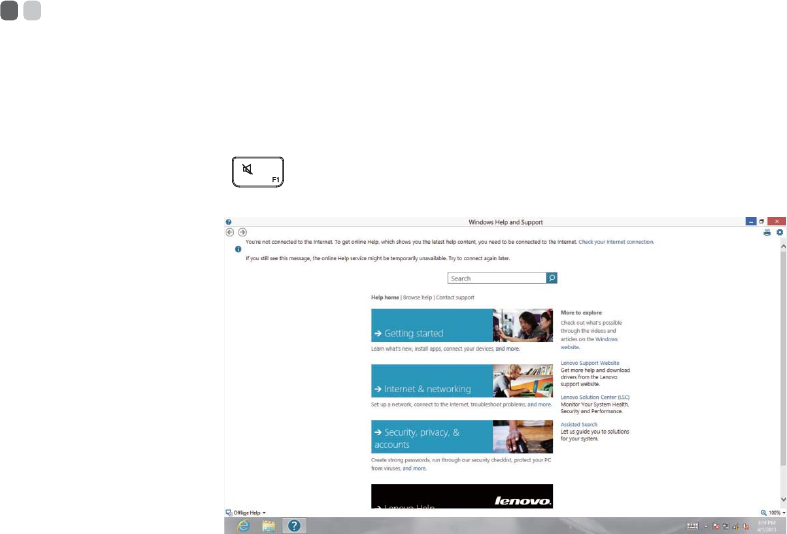
Chapter 2. Starting to use Windows 8
19
Help and support - - - - - - - - - - - - - - - - - - - - - - - - - - - - - - - - - - - - - - - - - - - - - - - - - - - - - - - - - - - - - - - - - - - - - - - - - - - - - - - - - - - - - - - - - - - - - - - - - - -
If you have any problems using the operating system, see the Windows Help and Support file.
To open the Windows Help and Support file, do one of the following:
•Select the Settings charm, then select Help.
•Press Fn + F1 ( ). (located on the folio case)
You can read the Windows Help and Support file on your computer. You can also get online help
and support by clicking the link listed under More to explore.

20
Chapter 2. Starting to use Windows 8
Recovery system - - - - - - - - - - - - - - - - - - - - - - - - - - - - - - - - - - - - - - - - - - - - - - - - - - - - - - - - - - - - - - - - - - - - - - - - - - - - - - - - - - - - - - - - - - - - - - - - - -
Introduction
Push-button reset is a built-in recovery tool that allows users to restore their operating system
to its original state while preserving their data and important customizations, without the need
to back up their data in advance.
The following Push-button reset features are available to users from multiple locations within
Windows:
Refreshing the computer
Fixes software problems by reinstalling the factory default configuration while preserving the
user’s data, important settings, and any Windows Store apps previously purchased from the
Windows Store.
Resetting the computer
Prepares the computer for recycling or for the transfer of ownership by reinstalling the factory
default configuration and returning all user data and applications to the state of their original
Out-of-Box Experience (OOBE).
Using Push-button reset
Push-button Reset can be launched using one of the following methods:
•Power button + Volume up button:
1
Shut down the tablet and wait about five seconds.
2
Press and hold the Power button and the volume up button together for at least four
seconds.
•Windows PC setting o General o Advanced startup o select Restart now
•Settings charm:
1
Select Power.
2
Press and hold the Shift key while selecting Restart.
For more instructions, see the Windows Help and Support file on your
computer.

21
Chapter 3. Troubleshooting
Frequently asked questions - - - - - - - - - - - - - - - - - - - - - - - - - - - - - - - - - - - - - - - - - - - - - - - - - - - - - - - - - - - - - - - - - - - - - - - - - - - -
This section lists frequently asked questions by category.
Finding information
What safety precautions should I follow when using my computer?
The Lenovo Safety and General Information Guide which came with your computer contains safety
precautions for using your computer. Read and follow all the precautions when using your
computer.
Where can I find the hardware specifications for my computer?
You can find hardware specification for your computer on the printed flyers which came with
your computer.
Where can I find warranty information?
For the warranty applicable to your computer, including the warranty period and type of
warranty service, see the Lenovo limited warranty flyer that came with your computer.
Drivers and preinstalled software
Where are the installation discs for Lenovo preinstalled software (desktop software)?
Your computer did not come with installation discs for Lenovo preinstalled software. If you
need to reinstall any preinstalled software, you can find the installation program on the C
partition of your hard disk. If you cannot find the installation program there, you can also
download it from the Lenovo consumer support website.
Where can I find drivers for the various hardware devices of my computer?
If your computer is preinstalled with a Windows operating system, Lenovo provides drivers for
all the hardware devices that you need on the C partition of your hard disk. You can also
download the latest device drivers from the Lenovo consumer support website.
Getting help
How can I contact the customer support center?
See “Chapter 3. Getting help and service” in the Lenovo Safety and General Information Guide.

22
Chapter 3. Troubleshooting
Troubleshooting - - - - - - - - - - - - - - - - - - - - - - - - - - - - - - - - - - - - - - - - - - - - - - - - - - - - - - - - - - - - - - - - - - - - - - - - - - - - - - - - - - - - - - - - - - - - - - - - - - - - - -
If you do not find your problem here, see Chapter 1. The following section only describes problems
that might negate the need to refer to the more comprehensive information in Chapter 1.
Display problems
When I turn on the computer,
nothing appears on the
screen.
•If the screen is blank, make sure that:
-The AC power adapter is connected to the computer, and
the power cord is plugged into a working electrical outlet.
-The computer power is on. (Press the Power button again
for confirmation.)
•If these items are properly set, and the screen remains blank,
have the computer serviced.
The screen goes blank while
the computer is on.
•Your power management is enabled. Do one of the following
to resume from sleep or hibernation mode:
- Press any key on the keypad. (located on the folio case)
-Press the Power button.
-Press the Windows button.
-Press F9 ( ) to confirm whether or not the backlight
of the LCD screen has been turned off. (located on the folio
case)
Sleep or hibernation problems
The critical low-battery error
message appears, and the
computer immediately turns
off.
•The battery power is getting low. Connect the AC power
adapter to the computer.
The computer enters sleep
mode immediately after
Power-on.
•Make sure that:
-The battery is charged.
-The operating temperature is within the acceptable range.
See “Chapter 2. Use and care Information” in the Lenovo
Safety and General Information Guide.
Note: If the battery is charged and the temperature is within range, have the computer serviced.
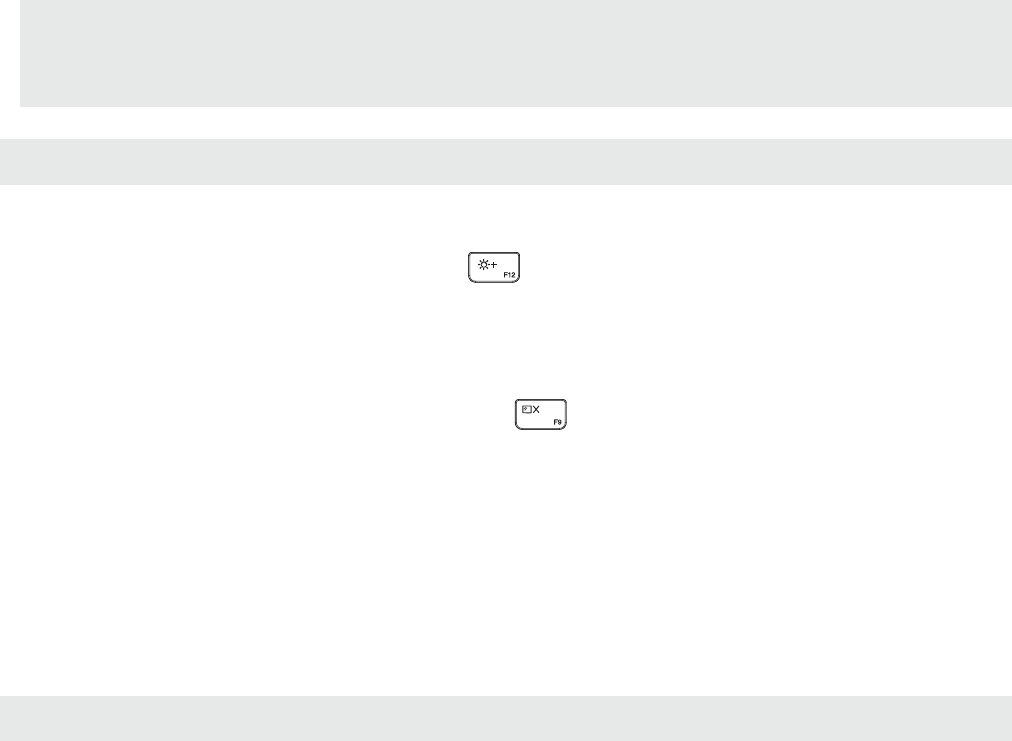
Chapter 3. Troubleshooting
23
The computer does not
return from sleep mode and
the computer does not work.
•If the computer does not return from sleep mode, it may
have entered hibernation mode automatically because the
battery is depleted.
•If your computer is in sleep mode, connect the AC power
adapter to the computer, then press the Windows button or
the Power button.
•If your computer is in hibernation mode or powered-off,
connect the AC power adapter to the computer, then press
the Power button to resume operation.
Note: If the system still does not return from sleep mode, your system has stopped responding, and you
cannot turn off the computer; reset the computer. Unsaved data may be lost. To reset the computer, press
and hold the Power button for five seconds or more. If the computer still does not reset, remove the AC
power adapter.
Display panel problems
The screen is blank. • Do the following:
- If you are using the AC power adapter or the battery, press
F12 ( ) to make the screen brighter.
- Press the Power button to confirm whether or not the
computer is in sleep mode.
- If the problem persists, follow the solution in the next
problem “The screen is unreadable or distorted.”
-Press F9 ( ) to confirm whether or notthe backlight
of the LCD screen has been turned off.
The screen is unreadable or
distorted.
•Make sure that:
- The screen resolution and color quality are correctly set.
- The monitor type is correct.
Incorrect characters appear
on the screen.
•Are the operating system or programs installed correctly?
If they are installed and configured correctly, have the
computer serviced.
Sound problems
No sound can be heard from
the speaker even when the
volume is turned up.
•Make sure that:
- The Mute function is off.
- The combo audio jack is not being used.
- Speakers are selected as the playback device.
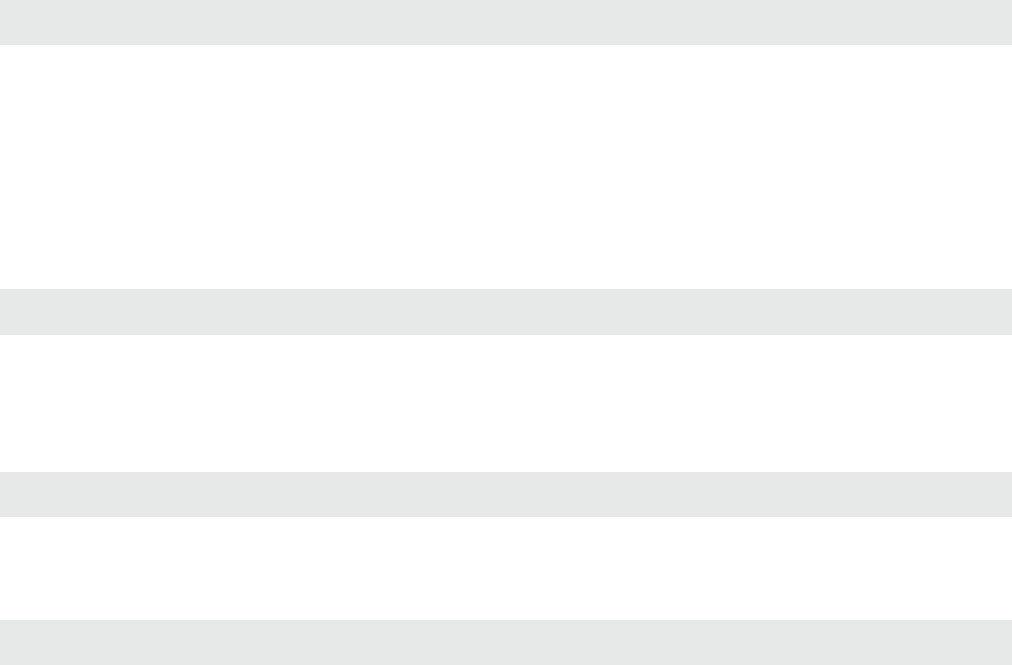
24
Chapter 3. Troubleshooting
Battery problems
Your computer shuts down
before the battery status icon
shows empty.
-or-
Your computer operates after
the battery status icon shows
empty.
•Recharge the battery.
A startup problem
The Microsoft® Windows
operating system does not
start.
•For details, see “Recovery system” on page 20.
Recovery System problems
Failure to restore system
partition to factory default.
•The system partition (e.g. the partition size or the drive
capacity of C) has been modified.
Other problems
Your computer does not
respond.
•To turn off your computer, press and hold the Power button
for five seconds or more. If the computer still does not
respond, remove the AC power adapter.
•Your computer might lock when it enters sleep mode during
a communication operation. Disable the sleep timer when
you are working on the network.
25
Trademarks
Lenovo is trademark or registered trademark of Lenovo in the United States, other countries, or both.
Microsoft and Windows are trademarks of Microsoft Corporation in the United States, other
countries, or both.

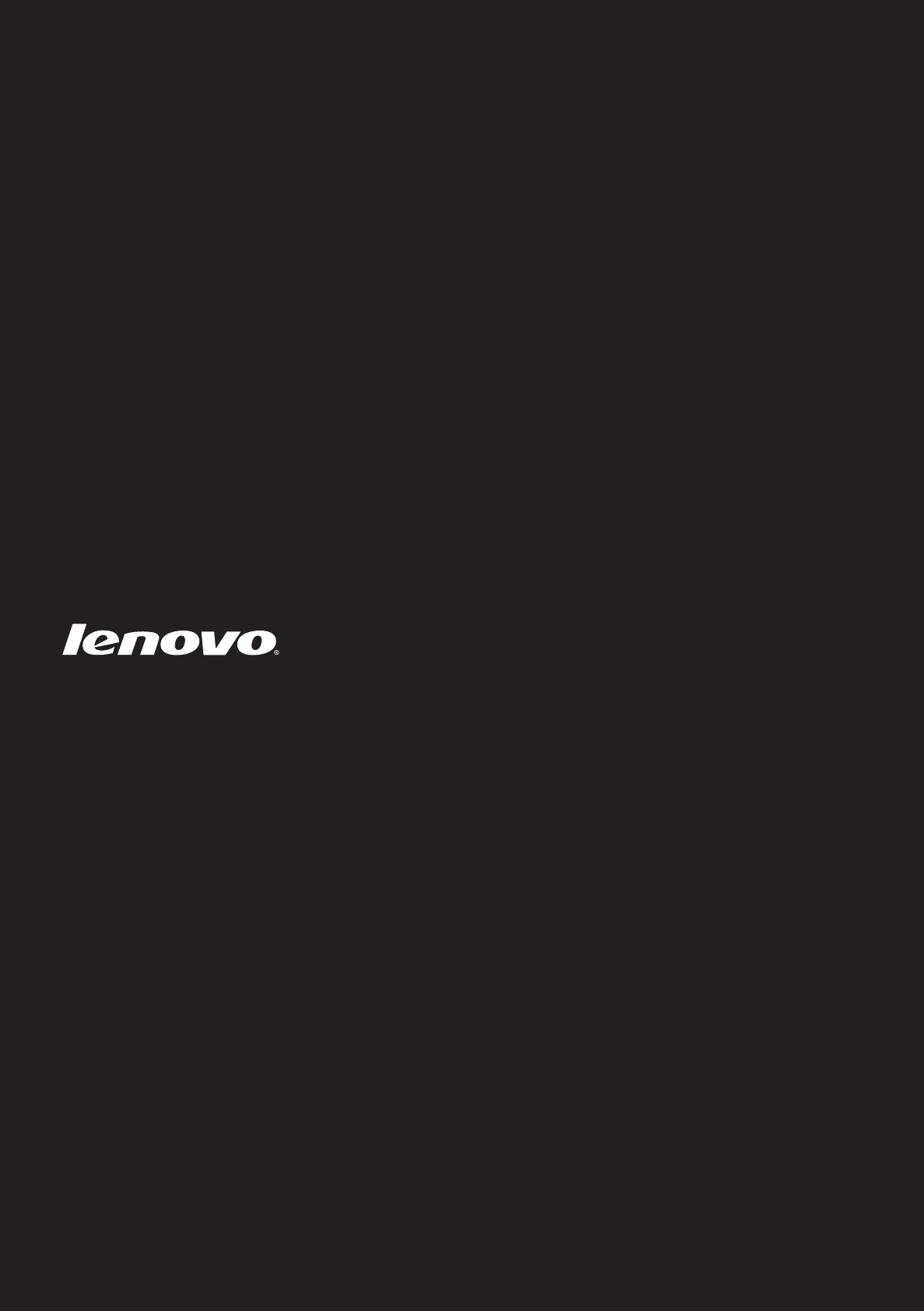
en-US
Rev. AA00
©Lenovo China 2013